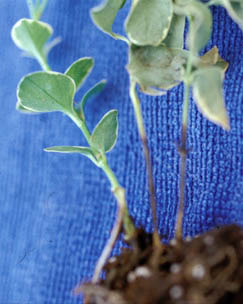Vinca Blight Easy to Spot Now | |
|---|---|
| May 28, 2008 | |
|
Take a close look now at any vinca you might have as a ground cover. New growth will contrast nicely with struggling stems and foliage. Pull back the foliage in punky-looking areas and look for symptoms that suggest a problem with Phoma stem blight. Try to inspect plants when they are dry to avoid spreading the disease further in the bed. Because low light, excessive water, nutrient stress, cool temperatures, and poor drainage can also cause weak plants, review the symptoms of this vinca disease. There are few things you can do now to help the plants this season. Vinca stem blight is a fungal disease problem of periwinkle (vinca) that can be very persistent once it invades a site. It is caused by a fungus named Phoma exigua var. exigua. The fungus thrives in moist conditions, such as those found in dense plantings of ground covers, especially in the spring when there is plenty of moisture and succulent tissue. Expect to see problems again this year. Conditions have been ideal for infection and spread. Black lesions may develop on the leaves and stems first, often girdling and killing runners. The image shows a healthy plant on the left and two infected stems on the right.  Stems and foliage become brown as they are killed by this fungus. Sometimes these patches are obvious, and other times the patches are hidden by new growth. If you see the black lesions, look for pinhead-sized fruiting bodies of the fungus in the black tissue. A look-alike disease, Rhizoctonia root rot of vinca, causes top decline by rotting the roots. It may also cause black stem lesions, but you won’t find fruiting bodies in the lesions. Dig up an infected plant and look at the root system. Phoma does not cause a root rot. The Plant Clinic can help distinguish between these diseases. Visit the Web site at http://plantclinic.cropsci.uiuc.edu/ for details on how to send a sample, fees, and address of the clinic. Stems and foliage become brown as they are killed by this fungus. Sometimes these patches are obvious, and other times the patches are hidden by new growth. If you see the black lesions, look for pinhead-sized fruiting bodies of the fungus in the black tissue. A look-alike disease, Rhizoctonia root rot of vinca, causes top decline by rotting the roots. It may also cause black stem lesions, but you won’t find fruiting bodies in the lesions. Dig up an infected plant and look at the root system. Phoma does not cause a root rot. The Plant Clinic can help distinguish between these diseases. Visit the Web site at http://plantclinic.cropsci.uiuc.edu/ for details on how to send a sample, fees, and address of the clinic.Remove infected plants, including old runners that may be hidden among other plants. Clean out dead leaves to open up air movement in the bed. When irrigation is needed, water the soil rather than the foliage. There are many fungicide options to protect new growth. Those with some systemic activity and listed in the Illinois Commercial Landscape and Turfgrass Pest Management Handbook include 18 Plus, 26 GT, Banner MAXX, Chipco 26019, Compass, Cygnus, Heritage, Iprodione, ProPensity, Propiconazole, Savvi, Sextant, Spectator, and Zyban. There are also protective contact products available, including Armicarb, Camelot, Champion, Kocide, Medallion, Pentathlon, and Protect. Compass-O is locally systemic and can be used only in production nurseries. Fungicide applications should be initiated when the disease first appears. For more information about this disease, refer to Report on Plant Disease, no. 640, “Stem Blight of Vinca” (http://www.ag.uiuc.edu/%7Evista/horticul.htm). | |
| Author: | Nancy Pataky |
